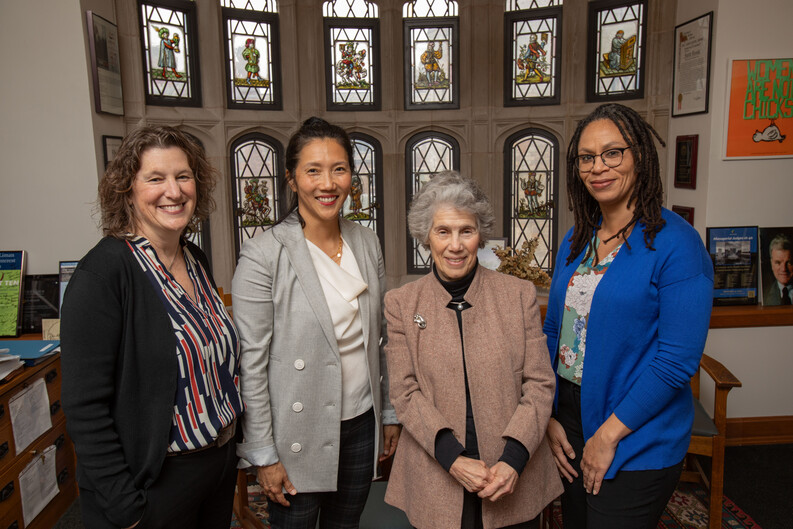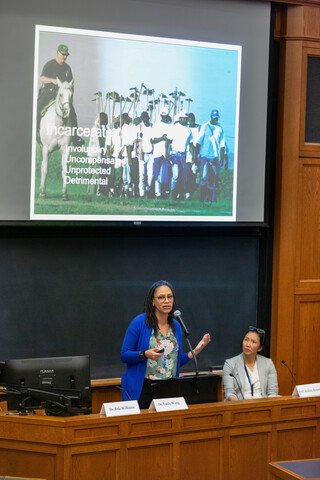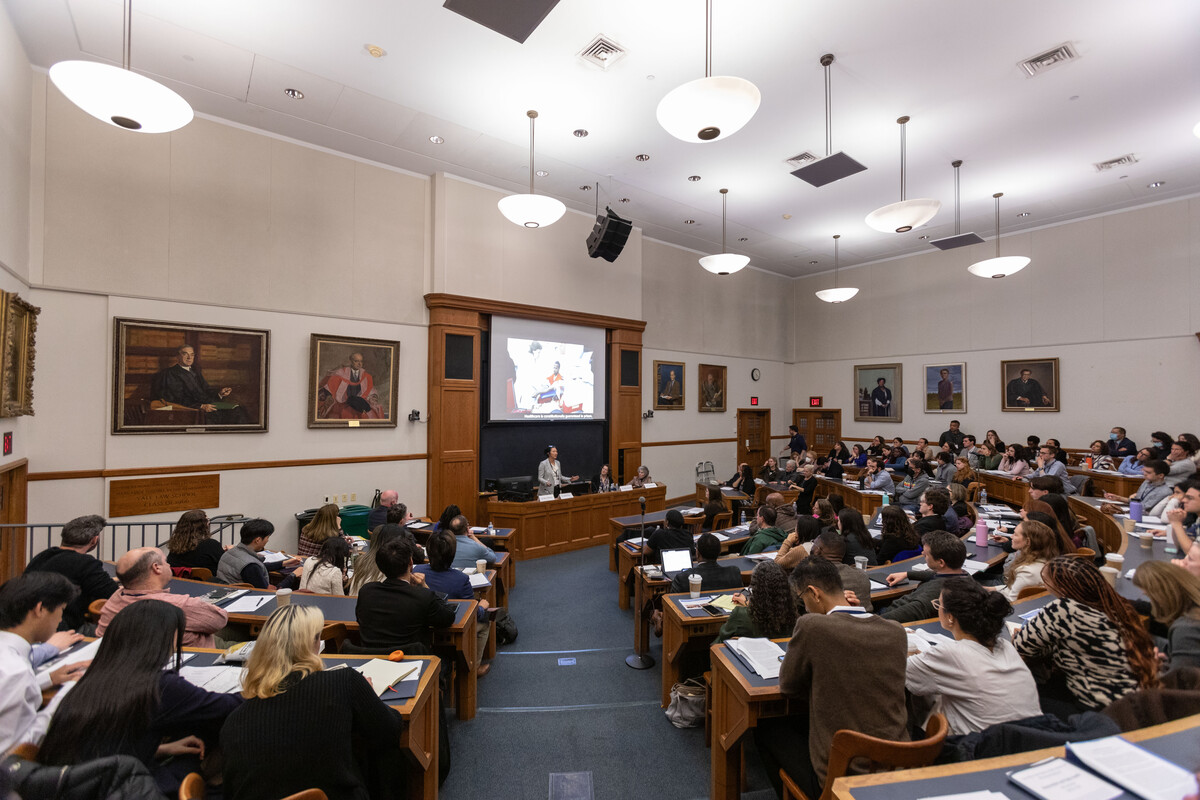Liman Colloquium Examines Incarceration’s “Toxic” Effects on Public Health

Incarceration raises health care problems for people when they are in prison, when they leave, and for the communities in which they live, according to experts. Given the range of work, litigation, proposed legislation, and research by advocates to lessen the harms of time spent in jail and prison, the Arthur Liman Center for Public Interest Law4 chose incarceration and public health as its topic for the 27th annual colloquium5. The event took place at Yale Law School on April 4 and 5.
Joined by its co-sponsors, the Liman Center welcomed more than 100 people to the two-day event to explore detention’s impact on health. Participants discussed topics including how the environment of jails and prisons affects incarcerated individuals, staff, and communities; the impact of gender, race, and other differences; and health care costs and sources of financing. They also talked about models of health care oversight, the state of law and litigation, strategies for decarceration, and research and changes both underway and needed. Colloquium co-sponsors were the Solomon Center for Health Law and Policy at Yale Law School, the SEICHE Center for Health and Justice at Yale, the Fines and Fees Justice Center, the Policy Advocacy Clinic at UC Berkeley Law School, and the Brennan Center for Justice at NYU Law School.
Involuntary labor causes injuries and deaths
The colloquium’s opening session, “Detention’s Toxicity,” began with Andrea Armstrong ’07, a leading national expert on prison and jail conditions. Armstrong is the Dr. Norman C. Francis Distinguished Professor of Law at Loyola University New Orleans College of Law and 2023 MacArthur Fellow. She founded Incarceration Transparency6, a research project that documents and memorializes deaths behind bars in Louisiana and supports similar efforts in South Carolina and Alabama. Arthur Liman Professor of Law and Liman Center Founding Director Judith Resnik moderated the session.
We should know how many people are dying in prisons and jails because those are our institutions. We fund them. They belong to us.”
— Andrea Armstrong ’07
Armstrong asked participants to consider the experience of Joe Palmer, a 71-year-old Black man from Shreveport, Louisiana, incarcerated for 47 years in the state’s prisons. In a video interview, Palmer described harvesting okra in intense heat, suffering cuts on his hands and arms from the sharp plants, being punished with solitary confinement if he didn’t make his quota, and having no access to bathrooms.
“When I first went there, I was assigned to the field,” Palmer said. “You work from 7:00 in the morning ’til about 3:00 in the afternoon, close to 4:00 when you come in. And it was hot. And I mean hot … They worked you out. When I say slavery, I don't think that's nothing but legalized slavery.”
Armstrong stressed that incarcerated labor happens not just in prisons across the country, but also in immigration detention and jails, where work is “involuntary, uncompensated, unprotected, and detrimental,” she said. In addition to causing injuries, compounding harms of inadequate healthcare systems, forced labor is also one source of carceral deaths which are “uncounted and uninvestigated,” she explained. Together, labor, healthcare, and deaths are emblematic of a broader “carceral toxicity” that harms people and communities, according to Armstrong.

Armstrong’s project intervenes to count and investigate custodial deaths. From the work of her students obtaining public records, we know that deaths in Louisiana prisons and jails are spiking and we are seeing stark increases in deaths due to suicide and drugs.
“We should know how many people are dying in prisons and jails because those are our institutions,” Armstrong said. “We fund them. They belong to us.”
Prison health problems extend to staff
Dr. Brie Williams, Professor of Medicine at the Center for Vulnerable Populations at the University of California, San Francisco, spoke about the impact of carceral facilities on staff who she noted are often from the same communities and the same neighborhoods as people who are incarcerated, and who also experience poor access to healthcare. Staff have similarly high rates of chronic health conditions as people who are incarcerated, Williams said.
Williams described data about staff experiences of threats of violence. Withdrawal, isolation, and conflict at home are common, as are elevated rates of severe depression, suicide, domestic violence, and substance use disorder, she said. According to One Voice United, an advocacy organization representing correctional officers, on average, a correctional officer's life expectancy is between 59 and 62 years — about 20 years shorter than the national figure.
Williams founded and directs AMEND7, a training and leadership development program that draws on public health, medical ethics, occupational health, and correctional practices from Norway and beyond. The program seeks to inspire, educate, and empower prison staff to address conditions in U.S. prisons that perpetuate trauma, violence, and health inequities among incarcerated people and prison staff. (Read about the program in a UC San Francisco feature.8) Dr. Williams also co-directs the Aging Research in Criminal Justice Health (ARCH) Network, which aims to expand research at the intersection of aging, serious illness, and criminal legal system involvement.
Prison practices from Norway offers an alternative
Williams described how prisons operate in Norway, where officials “believe that life inside prisons should resemble life outside as much as possible, as the point is to return people to life outside,” she said. “For example, prisons have supermarkets inside to teach people how to manage budgets, how to cook food, how to make food for their families.”
In contrast, Williams explained, in the United States, “nothing is normal in prison. People are, at times, held in cages where the focus — rather than on becoming a better neighbor — is on becoming a better prisoner.”
Williams described her organization’s success adapting approaches from Norway to train officers and other staff in U.S. prisons, and her organization’s hopes to expand that model to more jurisdictions. The organization launched the first Norwegian-style resource team in Oregon in 2019. The pilot project was the subject of a case study9.
“The goals were to maximize time out of cells, out of restraints for people who have been down for decades in restrictive housing units and who had not come out of their cell except in restraints, and to have done so with no increase in violence and no increase in use of force,” Williams said. “In our three-year pre-post, we found a 56% reduction in disciplinary infractions and a 74% reduction in assaults across the units.”
Health care guaranteed in prison, but quality is not
The session concluded with Dr. Emily Wang, a 2022 MacArthur Fellow and Professor of Medicine and Public Health at Yale. Wang is the Director of the SEICHE Center for Health and Justice, a collaboration between Yale School of Medicine and Yale Law School. While a medical resident, Wang provided care to people held on California’s death row.
“Because healthcare is constitutionally guaranteed behind bars, for this large, disproportionately racially minoritized population of young adults, oftentimes this is the place where they first experience healthcare,” Wang said.
Wang and the SEICHE Center are committed to direct clinical care of people involved in the criminal law enforcement system, to research and scholarship, to education of health students and professionals, and to informing and joining in legal advocacy to lessen and end massive incarceration. As an internist, she has cared for thousands of individuals with a history of incarceration and is co-founder of the Transitions Clinic Network, a consortium of 48 community health centers nationwide dedicated to caring for individuals recently released from carceral facilities and employing community health workers with histories of incarceration.

Prison health care comes with barriers, limits
According to Wang, about 40% of incarcerated individuals receive their first diagnosis of chronic health conditions such as hypertension, hepatitis C, and substance use disorder while in custody. Even as prison is a place where people have a constitutional right to healthcare, access while incarcerated is both limited and comes with barriers such as having to make co-payments.
“In Connecticut, there's a $3 co-payment,” Wang explained. “One might think, ‘Well, what's three bucks? A person who is incarcerated may make 75 cents a day for work in prison. It’s four days’ worth of work to see a physician.”
She also described how the process of seeing a doctor can be complex and difficult for incarcerated patients to navigate. The process usually begins with submitting a medical request form.
“In lots of correctional systems, the first person that’s looking at the form is a correctional officer,” Wang said. “After the correctional officer looks at it, then it’s a nurse, and then after that, it goes to a physician. While there’s a constitutional guarantee to healthcare, that access is filtered through the carceral system. Your need is interpreted by others who don’t have healthcare training or necessarily health care interest first at heart. The quality of care that is delivered is variable and rarely assessed.”
People with specific conditions and medication needs are at particular risk. Wang offered the example of opioid use disorder: though the condition is common among incarcerated people, the vast majority of prison systems limit access to treatment medications and many jails offer no access at all, “because the decisions about what medicines are available are decisions that correctional system leaders make,” Wang explained.
“It’s not a physician that’s deciding what's on the formulary. It’s not a decision that the governance system or the public health system is making,” Wang said. “These decisions are made by people who are not medically trained.”
Wang’s research has demonstrated the heightened risk of illness and death faced by individuals upon leaving incarceration. She cited a pioneering study by Ingrid A. Binswanger and co-authors that found that individuals are 12 times more likely to die within the first two weeks of being released from custody. The deaths when people come home are from overdose, heart disease, cancer, and suicide, according to the study. Her team has found similarly high risks using national data in Medicare beneficiaries.
“There’s an urgency to the science now, especially for families and communities,” Wang said. “We focus so much on the individuals that have been directly impacted. For each person that's behind bars, there are families and whole communities that have been impacted where the toxicities are also present.”


